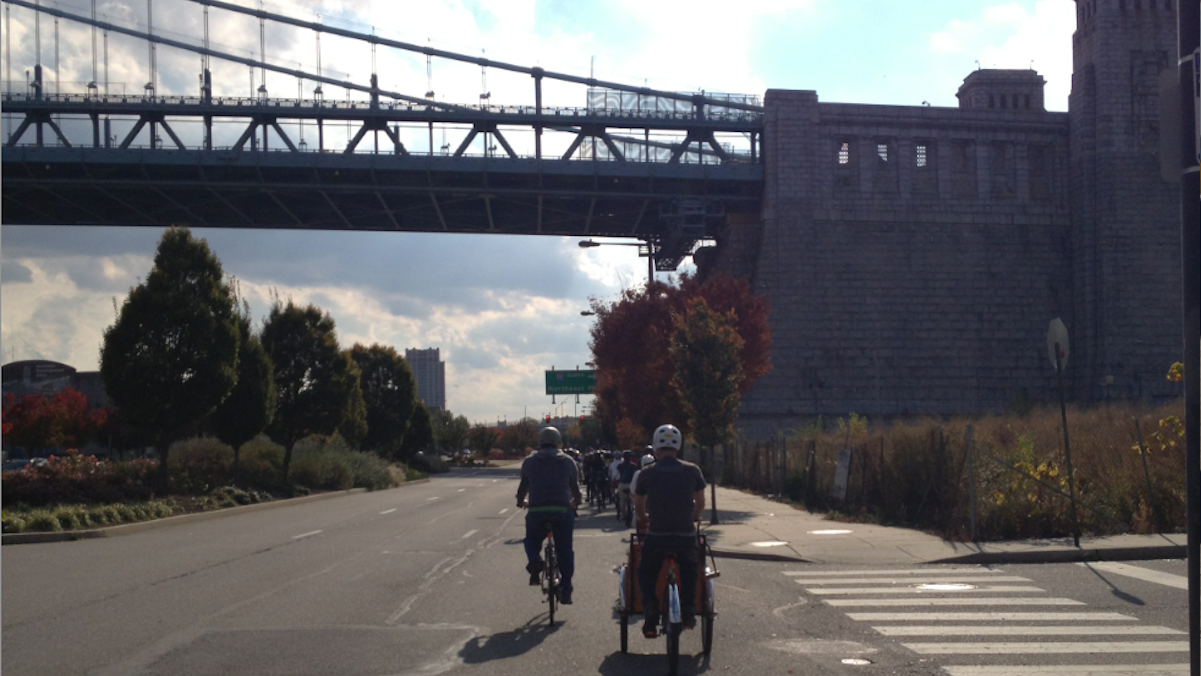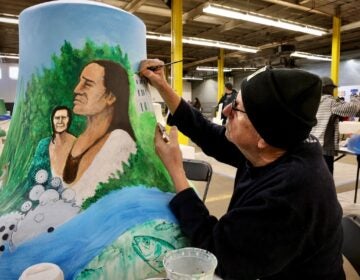What one avid bicyclist wants from Philadelphia’s next mayor

Bicyclists riding on Delaware Avenue's unprotected bike lane. (Dena Driscoll/for NewsWorks)
Bicyclists certainly do not own Philadelphia, but considering theirs is a growing mode of transportation among city dwellers, they are a key voting demographic in the looming mayoral-election season.
Philadelphia, an emerging 21st Century City, is having a moment. That’s according to the latest Visit Philly campaign which features a high-paced video montage that includes a bright flash of a green bike lane and bicyclist riding down the Ben Franklin Parkway.
I am a millennial, mother and a bicyclist who lives and works in Philadelphia.
Although I have been appreciative of Mayor Michael Nutter’s work during the past seven years — most notably the buffered bike lanes on Spruce and Pine streets and the introduction of Philly Bike Share — I am ready to usher new leadership in Philadelphia.
I am hoping the next mayor is ready to make a bigger investment toward making a bikeable 21st Century City.
Trickle-down safety
By making Philadelphia’s streets safer for families like mine who bike, such an effort would also make it safer for families like yours to walk, use public transportation or drive.
Bike infrastructure is proven to reduce all traffic injuries, not just those suffered by bicyclists.
In 2013, the New York City Department of Transportation reported that “because they shorten crossing distances, control turning conflicts and reduce traffic weaving, New York City’s protected bike lanes reduced injury rates for people walking on their streets by 12 to 52 percent” (PDF).
Street-protected bike lanes also reduce the pesky sidewalk biking that just about everyone in Philly hates.
“Where protected lanes were installed in New York and Washington D.C., the number of bikes on sidewalks immediately fell by an average of 56 percent,” the report found.
Even if you aren’t a bicyclist — yet! — certain changes could help make our city a wonderfully livable place.
Embrace ‘Vision Zero’ efforts
First and foremost, Philadelphia’s future mayor and City Council should support the adoption of a Vision Zero policy.
Developed in Sweden, Vision Zero aims to reduce all traffic fatalities to zero; New York City and San Francisco have recently adopted it.
A Dec. 2014 report from the Bicycle Coalition of Greater Philadelphia (PDF) regarding vulnerable road users calls for its adoption and a 50-percent reduction in traffic fatalities by 2020.
Why is this important?
No matter your mode of transportation, no one should die from easily remedied street-design flaws. Those who misuse infrastructure, i.e. speeding, must be held accountable.
Now for the good news: Eighth District City Councilwoman Cindy Bass has called for hearings on a Vision Zero plan.
In doing so, she cited a Coalition report which included the staggering realization that traffic-related injuries and deaths cost the city $1 billion annually.
Physical-infrastructure needs
The city should also invest in on-street bicycle infrastructure.
I do not mean painted “sharrows” and “bike lanes.” Rather, I mean truly dedicated bike lanes that separate cars from bicycles, via physical barrier, on busy streets. They also prioritize safety for bicyclists and pedestrians on less-traveled streets.
This network of lanes should take residents to places they need to access: Schools, work, grocery stores, day-care facilities, shopping centers and the like.
This is what they do in the Netherlands and Denmark, where we see the highest amount of bicycle users and the least number of crashes or conflicts.
Economic impact
It is time for City Council to get out of the way of improvements like what we saw with the 22nd Street bike lane. They need to understand that bicyclists are also good for business.
Many cities report large increases in sales for shops located along dedicated bike infrastructure. By preventing the expansion of bicycle infrastructure improvements, we are reducing not only safety but economic growth of businesses.
While bike infrastructure is a significantly cheaper investment compared to other car-related street changes, Philadelphia’s streets-related budget is markedly lower than that in similar cities.
Not only that, but the Streets Department has a back log for paving and other improvements that the budget availability does not match.
We must demand that our incoming City Council and mayor dedicate more money to the Streets Department so we can further allocate resources to improve all our streets and bridges.
Bicyling’s impact on parking
Now for the elephant in the room: Parking.
While parking is a desirable commodity, civic leaders need to stop tiptoeing around the issue of limiting, or increasing the cost of, curbside parking. Parking prices need to match the demand side of things.
No one deserves to put my, or anybody’s, children in danger because they think they have a right to park/stop/unload in the bike lane or block a curb cut.
We need the political power of our top officials to unblock our bike lanes and sidewalks, increase cost of curb parking, provide more on-street bicycle-parking corrals and install additional designated loading zones.
Finally, we need open streets!
Streets are the largest concentration of public space in the city. When it is solely reserved for vehicular usage — parking and driving — we aren’t truly capitalizing on its promise.
We need more pedestrian plazas and more open street days, the popularity of which can be seen through fall festivals that pack roadways with people on foot.
All of which is to say that when new leadership comes into City Hall, the time will be right to take back the streets of Philadelphia.
WHYY is your source for fact-based, in-depth journalism and information. As a nonprofit organization, we rely on financial support from readers like you. Please give today.




